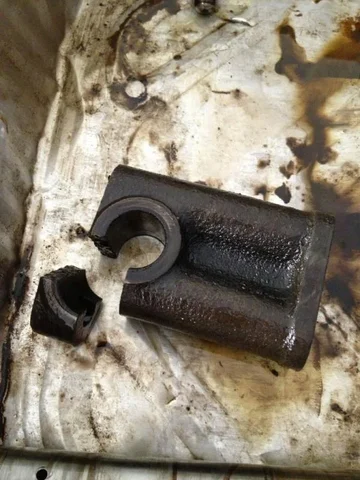Today, I made it out to the barn to put a little sweat equity in the Land Cruiser. I dug through bins of parts to find some brackets, bolts, and bits.
Then I started cleaning, painting, organizing, and assembling stuff. Let's add photos, so I can save a few thousand words from this post.
I dug out the fuel pump. Looks like oldie-but-goldie type with manual primer. I bench tested it with my fingers over the inlet and outlet to find out that it might still work! Armed with excitement, I used some WD-40 and a brass-wire brush to gently clean it up. Not
Concourse d'Elegance quality cleaning job here, but I can live with it.
Then, I sorted out some bolts. When my clutch parts arrive, I want to be ready to assemble the drivetrain on the chassis. I found motor mount bolts and a few others that go in the block.
IMPORTANT: The threads for the motor mounts are M10x1.25 JIS bolts. For whatever reason, the block is threaded M10X1.50 for the alternator brackets. This confused me a bit, but luckily I figured it out before getting out my M10x1.25 tap and chasing threads.
I found some clean bolts that looked like they should be the correct ones for the side cover. I assembled with my new SOR gasket. I did not use any silicon to provide additional sealing. I hope I don't need to.
I cleaned my oil pan. The contents were so nasty that my parts washer solvent is ruined. For that matter, the pump is clogged. I need to remedy that soon. After getting the 1-2 mm thick sludge layer out in the parts washer, I still had another stubborn gritty layer lining the interior of the pan yet. This was rectified with a gasoline soaked rag and elbow grease. The exterior of the pan was sand blasted. The crotch between the skid plate and the pan was still dirty, so I picked at it until I was fed up. I painted of the rest and installed using new zinc-plated bolts. Pretty, huh?
I don't know why my camera was taking grainy pictures. I am not a very good camera handler or caretaker. That may be a major contributor to the picture quality.
Tip for installing old-fashioned gaskets:
Preface: Modern gaskets with wire reinforcements are great. They are reusable and can handle apes who over-torque everything. The silicon is pliable for long periods of time and seals imperfect surfaces admirably.
I like the old-school sometimes. Maybe it is misguided nostalgia (you are in the 40 section of MUD, by the way), but I think old soft cork gaskets are great. The new version of cork that almost seems semi-synthetic is cool, too. Flimsy rubber gaskets are not in my favor. The biggest reason I see for fresh cork gaskets leaking are from over-torquing. The trick is to watch the gasket as you tighten your fastener.
Tighten the fastener until you feel resistance at the gasket. The is where it starts compressing. Add just enough torque that you begin to see the gasket swell out of the gap it fills. If you get enough gasket displacement that it distorts, you just ruined the gasket. When finished, there should be the faintest bulge at each bolt when looking from above. Looking from the side, the gasket should be linear, not wavy. Wavy is distorted and over-tightened.
The alternator bracket should be installed before the motor mount, because it is easier that way.
The shorter motor mount goes on the driver side (with the alternator bracket).
The longer motor mount goes on the other side.
And finally, I put on the valve cover, just to see what it would look like (and to keep dust out of the motor). Valve cover got new zinc nuts for style points.
I'll try to figure out what happened to my camera so I can take better pictures next time.

 I'm gonna have to copy and print out your engine and u joint rebuild when I get to doing them. Thanks for all the detail and pics for those of us who've never tackled such a thing!
I'm gonna have to copy and print out your engine and u joint rebuild when I get to doing them. Thanks for all the detail and pics for those of us who've never tackled such a thing!






















